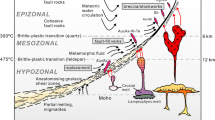Abstract
Experimental and thermodynamic data and the apparent immobility of Ti under metamorphic conditions suggest that rutile is very insoluble in aqueous fluids at upper crustal conditions. New solubility measurements at 1.0–2.93 GPa and 800–1200°C show, however, that under certain pressure and temperature conditions rutile is quite soluble in H2O. Solubilities were estimated from the measured weight loss of a single crystal equilibrated with a known mass of fluid in a piston cylinder apparatus. Measured solubilities in H2O range from 0.15 wt% (wt loss crystal/wt fluid) at 2.93 GPa and 1000°C to 1.9% at 1.0 GPa and 1100°C. Solubility increases with increasing temperature and with decreasing pressure in a manner given by the following fit to the experimental data:
wherem Ti is the molality of Ti in the fluid,T is in degress Kelvin andP is in MPa. The effect of fluid composition on rutile solubility was also examined at 1.0 GPa and 1000°C for H2O-CO2, 1m NaCl, and 1m HF fluids. Kesults suggest that solubility depends on the mole fraction of H2O in the fluid but is independent of ionic strength and fluid pH. This behavior implies that Ti dissolves as the neutrally-charged hydrolysis product Ti(OH)4. The free energy of this species was calculated for each set of experimental conditions. TheP-T dependence of rutile solubility suggests that aqueous fluids derived from subducted oceanic lithosphere would dissolve rutile or other Ti-rich minerals from the deepest portion of the mantle wedge and precipitate them at higher levels. Subsequent melting of the base of the mantle wedge would form HFSE-depleted IAB.
Similar content being viewed by others
References
Anders E, Ebihara M (1982) Solar-system, abundances of the elements. Geochim Cosmochim Acta 46:2363–2380
Anderson GM, Burnham CW (1965) The solubility of quartz in supercritical water. Am J Sci 263:494–511
Ayers JC (1991) Experimental studies of the chemistry of aqueous fluid-accessory mineral systems at high P-T conditions with implications for fluid-rock interactions. PhD thesis, Rensselaer Polytechnic Institute
Ayers JC, Watson EB (1991a) Rutile in high-pressure hydrothermal environments. EOS Trans Am Geophys Union 72:141–142
Ayers JC, Watson EB (1991b) Solubility of apatite, monazite, zircon, and rutile in supercritical aqueous fluids with implications for subduction zone geochemistry. Phil Trans R Soc London A 335:365–375
Ayers JC, Brenan JB, Watson EB, Wark DA, Minarik WG (1992) A new capsule technique for hydrothermal experiments using the piston cylinder apparatus. Am Mineral 77:1080–1086
Baes CF, Mesmer RE (1976) The hydrolysis of cations. Wiley, New York
Barnes HL (1981) Measuring thermodynamically-interpretable solubilities at high pressures and temperatures. In: Rickard D, Wickman F (eds) chemistry and geochemistry of solutions at high temperatures and pressures (Phys Chem Earth, vol. 13/14). Pergamon Press, New York, pp 321–343
Barsukova ML, Kuznetov VA, Dorofeyeva VA, Khodakovskiy LI (1979) Measurement of the solubility of rutile TiO2 in fluoride solutions at elevated temperatures. Geokhimiya 7:1017–1027
Becker KH, Cemič L, Langer KEOE (1983) Solubility of corundum in supercritical water. Geochim Cosmochim Acta 47:1573–1578
Brenan JB, Watson EB (1991) Partitioning of trace elements between olivine and aqueous fluids at high P-T conditions: implications for the effect of fluid composition on trace element transport. Earth Planet Sci Lett 107:672–688
Davies JH, Stevenson DJ (1991) Physical model of source region of subduction zone volcanics. J Geophys Res B 97:2037–2070
Deer WA, Howie RA, Zussman J (1962) Rock forming minerals, vol 5 (Non-Silicates). Longman, London
Dipple GM, Ferry JM (1992) Metasomatism and fluid flow in ductile fault zones. Contrib Mineral Petrol 112:149–164
Eugster HP, Baumgartner L (1987) Mineral solubilities and speciation in supercritical metamorphic fluids. In: Carmichael ISE, Eugster HP (eds) Thermodynamic modeling of geological materials: minerals, fluids, and melts (Reviews in Mineralogy vol 17). Mineralogical Society of America, Washington DC, pp 364–403
Foley SF, Wheller GE (1990) Parallels in the origin of the geochemical signatures of island arc volcanics and continental potassic igneous rocks: the role of residual titanates. Chem Geol 85:1–18
Frost BR (1991) Stability of oxide minerals in metamorphic rocks. In: Lindsley DH (ed) Oxide minerals: petrologic and magnetic significance. (Reviews in Mineralogy vol 25). Mineralogical Society of America. Washington DC, pp 469–488
Gieré R (1990) Hydrothermal mobility of Ti, Zr and REE: examples from the Bergell and Adamello contact aureoles (Italy). Terra Nova 2:60–67
Green TH, Pearson NJ (1986) Ti-rich accessory phase saturation in hydrous mafic-felsic compositions at high P, T. Chem Geol 54:185–201
Green TH, Pearson NJ (1987) An experimental study of Nb and Ta partitioning between Ti-rich minerals and silicate liquids at high pressure and temperature. Geochim Cosmochim Acta 51:55–62
Haggerty, SE (1991) Oxide mineralogy of the upper mantle. In: Lindsley DH (ed) Oxide minerals: petrologic and magnetic significance (Reviews in Mineralogy vol 25). Mineralogical Society of America, Washington DC, pp 355–416
Holloway JR (1981) Volatile interaction in magmas.In Newton RC, Navrotsky AC, Wood B (eds) Thermodynamics of minerals and melts (Advances in physical geochemistry vol 1). Springer, Berlin Heidelberg New York, pp 273–293
Lasaga AC (1991) The atomic treatment of mineral-water surface reactions.In Hochella MF, White AF (eds) Mineral-water interface geochemistry (Reviews in Mineralogy vol 23). Mineralogical Society of America, Washington DC, pp 17–86
Morris J, Leeman WP, Tera F (1990) The subducted component in island arc lavas: constraints from Be isotopes and Be-Be systematics. Nature 344:31–36
Oelkers EH, Helgeson HC (1988) Calculation of the thermodynamic and transport properties of aqueous species at high pressures and temperatures: aqueous tracer diffusion coefficients of ions to 1000°C and 5kb. Geochim Cosmochim Acta 52:63–85
Peacock SM (1990) Numerical simulation of metamorphic pressuretemperature-time paths and fluid production in subducting slabs. Tectonics 9:1197–1211
Pearce JA, Cann JR (1973) Tectonic setting of basic volcanic rocks using trace element analysis. Earth Planet Sci Lett 19:290–300
Philippot P, Selverstone J (1991) Trace-element-rich brines in eclogitic veins: implications for fluid composition and transport during subduction. Contrib Mineral Petrol 106:417–430
Robie RA, Hemingway BS, Fisher JR (1979) Thermodynamic properties of minerals and related substances at 298.15 K and 1 bar (105 Pascals) pressure and at higher temperatures. US Geol Surv Bull 1452
Ryerson FJ, Watson EB (1987) Rutile saturation in magmas: implications for Ti-Nb-Ta depletion in island arc basalts. Earth Planet Sci Lett 86:225–239
Saunders AD, Norry MJ, Tarney J (1991) Fluid influence on the trace element compositions of subduction zone magmas. Trans R Soc London A 335:377–392
Schneider ME, Eggler DH (1986) Fluids in equilibrium with peridotite minerals: implications for mantle metasomatism. Geochim Cosmochim Acta 50:711–724
Sorenson SS, Grossman JN (1989) Enrichment of trace elements in garnet amphibolites from a paleo-subduction zone: Catalina schist, southern California. Geochim Cosmochim Acta 53:3155–3178
Tatsumi Y, Hamilton DL, Nesbitt RW (1986) Chemical characteristics of fluid phase released from a subducted lithosphere and origin of arc magmas: evidence from high-pressure experiments and natural rocks. J Volcanol Geotherm Res 29:293–309
Turcotte DL, Schubert G (1982) Geodynamics: applications of continuum physics to geological problems. J Wiley and Sons, New York
Vidal P, Dupuy C, Maury R, Richard M (1989) Mantle metasomatism above subduction zones: trace element and radiogenic isotope characteristics of peridotite xenoliths from Batan Island (Philippines). Geol 17:1115–1118
Walther JV, Helgeson HC (1977) Calculation of the thermodynamic properties of aqueous silica and the solubility of quartz and its polymorphs at high pressures and temperatures. Am J Sci 277:1315–1351
Walther JV, Wood BJ (1986) Mineral-fluid reaction rates.In Walther JV, Wood BJ (eds) Fluid-rock interactions during metamorphism (Advances in physical geochemistry vol 5). Springer, New York Berlin Heidelberg, pp 194–211
White WM, Patchett J (1984) Hf-Nd-Sr isotopes and incompatible element abundances in island arcs: implications for magma origins and crust-mantle evolution. Earth Planet Sci Lett 67:167–185
Wood BJ, Walther JV (1986) Fluid flow during metamorphism and its implications for fluid-rock ratios.In Walther JV, Wood BJ (eds) Fluid-rock interactions during metamorphism (Advances in physical geochemistry vol 5). Springer, New York Berlin Heidelberg, pp 89–108
Wood BJ, Bryndzia LT, Johnson KE (1990) Mantle oxidation state and its relationship to tectonic environment and fluid speciation. Science 248:337–345
Author information
Authors and Affiliations
Rights and permissions
About this article
Cite this article
Ayers, J.C., Watson, E.B. Rutile solubility and mobility in supercritical aqueous fluids. Contr. Mineral. and Petrol. 114, 321–330 (1993). https://doi.org/10.1007/BF01046535
Received:
Accepted:
Issue Date:
DOI: https://doi.org/10.1007/BF01046535




